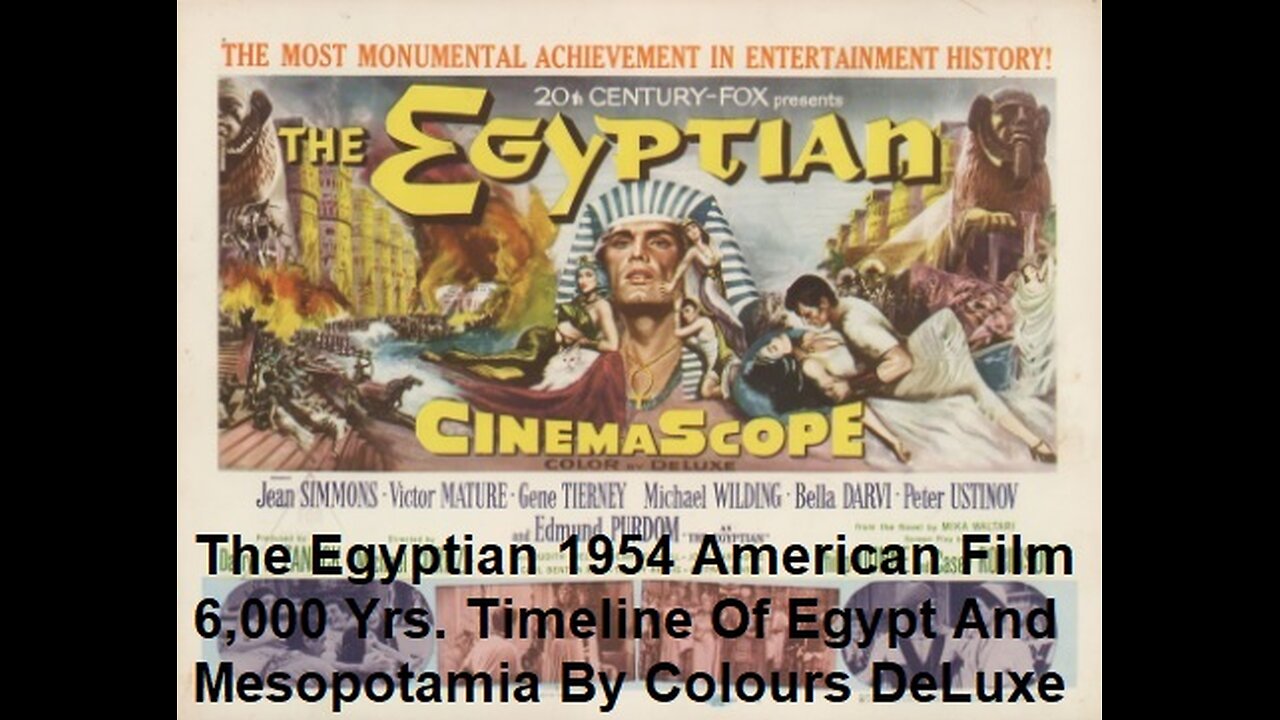Premium Only Content

The Egyptian is a 1954 American Film Timeline of Egypt and Mesopotamia by DeLuxe
The Egyptian is a 1954 American epic drama film made by 20th Century Fox. Filmed in CinemaScope with color by DeLuxe, it was directed by Michael Curtiz and produced by Darryl F. Zanuck. It is based on Mika Waltari's 1945 novel of the same name and the screenplay was adapted by Philip Dunne and Casey Robinson. Leading roles were played by Edmund Purdom, Bella Darvi, Jean Simmons, Victor Mature, Gene Tierney, Peter Ustinov, and Michael Wilding. Cinematographer Leon Shamroy was nominated for an Oscar in 1955.
Sinuhe (Edmund Purdom), a struggling physician in 18th dynasty Egypt (14th Century BC), is thrown by chance into contact with the pharaoh Akhnaton (Michael Wilding). He rises to and falls from great prosperity, wanders the world, and becomes increasingly drawn towards a new religion spreading throughout Egypt. His companions throughout are his lover, a shy tavern maid named Merit (Jean Simmons); and his corrupt but likable servant, Kaptah (Peter Ustinov).
While out lion hunting with his sturdy friend Horemheb (Victor Mature), Sinuhe discovers Egypt's newly ascendant pharaoh Akhnaton, who has sought the solitude of the desert in the midst of a religious epiphany. While praying, the ruler is stricken with an epileptic seizure, with which Sinuhe is able to help him. The grateful Akhnaton makes his savior court physician and gives Horemheb a post in the Royal Guard, a career previously denied to him by low birth. His new eminence gives Sinuhe an inside look at Akhnaton's reign, which is made extraordinary by the ruler's devotion to a new religion that he feels has been divinely revealed to him. This faith rejects Egypt's traditional gods in favor of monolatristic worship of the sun, referred to as Aten. Akhnaton intends to promote Atenism throughout Egypt, which earns him the hatred of the country's corrupt and politically active traditional priesthood.
Life in court does not prove to be good for Sinuhe; it drags him away from his previous ambition of helping the poor while falling obsessively in love with a Babylonian courtesan named Nefer (Bella Darvi). He squanders all of his and his parents' property in order to buy her gifts, only to have her reject him nonetheless. Returning dejectedly home, Sinuhe learns that his parents have committed suicide over his shameful behavior. He has their bodies embalmed so that they can pass on to the afterlife, and, having no way to pay for the service, works off his debts in the embalming house.
Lacking a tomb in which to put his parents' mummies, Sinuhe buries them in the sand amid the lavish funerary complexes of the Valley of the Kings. Merit finds him there and warns him that Akhnaton has condemned him to death; one of the pharaoh's daughters fell ill and died while Sinuhe was working as an embalmer, and the tragedy is being blamed on his desertion of the court. Merit urges Sinuhe to flee Egypt and rebuild his career elsewhere, and the two of them share one night of passion before he takes ship out of the country.
Olympic discus thrower Fortune Gordien and Jean Simmons on set.
For the next ten years Sinuhe and Kaptah wander the known world, where Sinuhe's superior Egyptian medical training gives him an excellent reputation as healer. Sinuhe finally saves enough money from his fees to return home; he buys his way back into the favor of the court with a precious piece of military intelligence he learned abroad, informing Horemheb (now commander of the Egyptian army) that the barbarian Hittites plan to attack the country with superior iron weapons.
Akhnaton is in any case ready to forgive Sinuhe, according to his religion's doctrine of mercy and pacifism. These qualities have made Aten-worship extremely popular amid the common people, including Merit, with whom Sinuhe is reunited. He finds that she bore him a son named Thoth (Tommy Rettig), a result of their night together many years ago, who shares his father's interest in medicine.
Meanwhile, the priests of the old gods have been fomenting hate crimes against the Aten's devotees, and now urge Sinuhe to help them kill Akhnaton and put Horemheb on the throne instead. The physician is privately given extra inducement by the princess Baketamun (Gene Tierney); she reveals that he is actually the son of the previous pharaoh by a concubine, discarded at birth because of the jealousy of the old queen and raised by foster parents. The princess now suggests that Sinuhe could poison both Akhnaton and Horemheb and rule Egypt himself (with her at his side).
Timeline of Egypt and Mesopotamia Ancient Mesopotamia and Ancient Egypt are among the oldest civilizations in human history. Ancient Egyptian civilization began in Africa along the Nile River and lasted over 3,000 years from 3150 BCE to 30 BCE.
Ancient Mesopotamia's civilization began between the Tigris and Euphrates Rivers near modern day Iraq.
Ancient Egypt began with two separate kingdoms: the Upper and Lower Kingdom.
Each kingdom’s king had a distinct crown. The crown of Upper Egypt was white and shaped like a cone. The crown of Lower Egypt was red, flat, and had a point in the back with a spiral in the front.
In 2950 BCE, Menes, the first Pharaoh, united the Upper and Lower Kingdoms.
Timeline of Egypt and Mesopotamia
This was the beginning of the first dynasties of Ancient Egypt, when being pharaoh was passed from one family member to another. It was also during this period in which the early writing system of hieroglyphics was created.
During the rise of Ancient Egypt in Africa, the earliest Mesopotamian civilization was also developing in Sumer. Although these civilizations did not make contact early on, they shared similar characteristics.
One characteristic they shared was the importance of religion. Both civilizations were polytheistic and worshipped multiple gods. Both civilizations also built amazing structures to honor their gods.
Egyptians built pyramids as tombs for their deceased Pharaohs.
The Great Pyramid of Giza is the largest of all the pyramids and was built as a tomb for the pharaoh Khufu around 2580 BCE. It took 20 years and 20,000 workers to complete.
Timeline of Egypt and Mesopotamia
Sumerians built temples called ziggurats where they performed religious rituals and ceremonies. Ziggurats were pyramid shaped buildings with a square base and steps leading up to several levels.
The Akkadians became the first empire in Mesopotamia beginning around 2300 BCE. With the use of his giant army, Sargon the Great was able to defeat many city-states and unite them into one empire. He kept his empire operating smoothly with the use of Akkadian bureaucrats positioned in every conquered city.
Eventually the Akkadian Empire fell and new empires arose in Mesopotamia.
In 1792 BCE, the Babylonian Empire became the largest and most powerful empire in Mesopotamia. Its ruler, Hammurabi, conquered all of the city-states of Mesopotamia and made Babylon the capital of his empire.
When King Hammurabi died, he left a great legacy behind him.
His set of laws, known as Hammurabi's Code, inspired other world leaders on how to govern their nations for the next thousand years.
Timeline of Egypt and Mesopotamia
Dynasties also rose and fell throughout Ancient Egyptian history. In around 1720 BCE, due to splitting the empire, Northern Egypt (Lower Kingdom) was invaded and taken over by the Hyksos.
The Hyksos ruled until 1550 BCE. During the “wars of liberation” from 1570-1550 BCE, kings Kamos and Ahmose I from Southern Egypt (Upper Kingdom) joined forces with the Nubians and fought together to defeat the Hyksos and expel them from Egypt.
Timeline of Egypt and Mesopotamia
Although pharaohs were mostly men, there were several female pharaohs in Ancient Egypt as well. The most powerful woman that held the title of pharaoh was Hatshepsut, who ruled from around 1479-1458 BCE. Hatshepsut accomplished many achievements during her reign. She was a powerful, intelligent, and gifted leader. She helped Egypt gain wealth by setting up trade with foreign countries. Many buildings and temples were also constructed during her reign in Egypt; however, her reign is mostly characterized by peace and prosperity.
One of the greatest pharaohs in Ancient Egypt was Ramses II (or Ramses the Great). He reigned from 1279-1213 BCE.
Ramses II was a military hero who defended Egypt against many attacks and expanded the Egyptian empire. He also built many great buildings and temples. He is known for the enormous statues of himself throughout Egypt.
He was buried in the Valley of the Kings and had many traps created inside of the tombs to deter grave robbers.
In Mesopotamia, another empire was reaching its peak. During 1500 BCE, the empire of Phoenicia reached its height through a long history of sea trading and manufacturing. They became the most skillful shipbuilders and navigators of their time. They also made glass items, dyes, jewelry, and other highly valued and prized goods.
Timeline of Egypt and Mesopotamia
In 1050 BCE, Egypt once again found itself falling into division as the New Kingdom ended. Many kingdoms fought for power and control over Egypt during this time. In the mid-700s BCE, the Kingdom of Kush became the dominant power in Upper Egypt. The Kush was a civilization centered in the North African region of Nubia.
Timeline of Egypt and Mesopotamia
A while later in Mesopotamia, the Babylonian Empire was reaching its peak. In 604 BCE, Chaldean ruler Nebuchadnezzar II became king of Babylon.
During his 43-year rule, he rebuilt the city of Babylon by restoring temples and building amazing structures like the Hanging Gardens of Babylon, his palace, and refortified the walls surrounding the city. Nebuchadnezzar II was a powerful conqueror and expanded the Babylonian Empire conquering cities such as Jerusalem.
In 539 BCE, the Babylonian Empire came to an end when Cyrus the Great conquered Mesopotamia and expanded the Persian Empire. He led his army in a surprise attack during the Babylonians' national feast.
Since the moats along the walls of Babylon were filled with water, Cyrus and his army rerouted the water making it hip level and easy for the army to walk through. Cyrus and his men then marched into the city and took control. The Persians were tolerant rulers who allowed conquered peoples to keep their own languages, religions and laws.
General Knowledge World Ancient, Medieval, Modern - World History Timeline
The following table illustrates the major events along with respective timeline −
Time Events
10000 BCE Middle East people domesticated goats and dogs.
9500 BCE Settled farming began.
6000 BCE Copper was discovered.
5000 BCE Sumerian civilization evolved between the rivers Euphrates and Tigris. Later it became popular as Mesopotamia (present day Iraq).
5000 BCE First calendar of 365 days, 12 months, and 30 days invented.
3500 BCE Bronze was discovered in Egypt.
3100 BCE First dynasty of Egypt.
3000 BCE Early writing.
2600 BCE Indus Valley civilization.
2560 BCE Great Pyramid of Giza.
2000 – 1200 BCE Iron Age.
1800 BCE Alphabetic writing appeared.
1700 BCE End of Indus Valley Civilization.
1400 BCE Water clock is invented in Egypt.
1027 BCE In China, Chou dynasty began.
850 BCE Homer had written the epic “Iliad and Odyssey”.
776 BCE Olympic Games first recorded.
753 BCE City of Rome was established by Romulus.
653 BCE Rise of Persian Empire.
600 BCE Sixteen Maha Janapadas emerged in India.
586 BCE The First Temple in Jerusalem (Solomon's Temple) was destroyed by the Babylonians.
550 BCE Pythagoras (Greek scholar) studied the movements of celestial bodies and mathematics.
509 BCE Founding of Roman Republic after exclusion of the last Roman King.
508 BCE Democracy introduced at Athens.
500 BCE Panini standardized the Sanskrit grammar and its morphology in the text Ashtadhyayi.
500 BCE Pingala learned the uses of zero and binary numeral system.
499 BCE Greco-Persian Wars.
490 BCE Battle of Marathon.
338 BCE In the Battle of Chaeronea, the king Philip II, defeated the combined forces of the Greek city-states Athens and Thebes.
337 BCE Philip II had created a strong and unified nation in Macedonia. He hired Aristotle (the Philosopher) to tutor his son, Alexander.
336 BCE Philip II was assassinated and Alexander became king.
331 BCE In the Battle of Gaugamela, Alexander the Great defeated Darius III of Persia.
326 BCE In the Battle of the Hydaspes River, Alexander the Great defeated Indian king Porus
323 BCE Death of Alexander at Babylon
300 BCE The Great Pyramid of Cholula constructed
221 BCE Qin Shi Huang unified China and the beginning of Imperial rule (in China)
221 BCE The Qin Dynasty began the construction of the Great Wall of China
206 BCE After the death of Qin Shi Huang, Han Dynasty established in China
200 BCE Paper is invented in China
124 BCE China's Imperial University was established
111 BCE First Chinese domination of Việtnam as the Nanyue Kingdom
4 BCE Birth of Jesus Christ (Widely accepted date)
Common Era (CE)
29 CE Jesus Christ crucified
70 CE The armies of Titus destructed Jerusalem
78 CE Origin of Saka Era in India
79 CE Mount Vesuvius erupted and destructed Pompeii and other towns (in Italy)
220 CE After the fall of Han Dynasty, three Kingdoms period begins in China
378 CE The Germanic tribes defeated Roman army in the battle of Adrianople
570 CE Prophet Mohammed (the founder of Muslim religion) born
581 CE Sui Dynasty came in China
613 CE Muhammad had commenced preaching publicly in his hometown, Mecca
622 CE Muhammad Migrated from Mecca to Medina
623 CE Muhammad abandoned Saturday as the Sabbath and made Friday as special day of the week
632 CE Muhammad died
660 CE The Quran, the holy book, was published for the first time
793 CE Scandinavians approached the island of Lindisfarne, Scotland by boat and they attacked monks and robbed their monastery. It is the first recorded raid by the Vikings
800 CE Gunpowder was invented
1050 CE An ancient tool of navigation namely The astrolabe” was first used in Europe
1077 CE Construction of the London Tower began
1117 CE The University of Oxford is established
1150 CE The University of Paris is established
1199 CE Europeans first used compasses
1209 CE The University of Cambridge is established
1215 CE John of England sealed the “Magna Carta”
1298 CE Marco Polo published his itinerary of China, along with Rustichello da Pisa.
1299 CE Osman I established the Ottoman Empire
1347 CE The Black Death withered Europe for the first (of many times). In the first year, an estimated 20 to 40% of the population was thought to have perished.
1389 CE Battle of Kosovo (in Serbia)
1397 CE The Medici bank was established in Florence
1461 CE King Loius XI of France started postal service
1492 CE Christopher Columbus discovered a route going to the New World (i.e. Caribbean Islands and America)
1498 CE Vasco da Gama arrived India
1503 CE Leonardo da Vinci started making the painting of Mona Lisa; however, completed after three years
1506 CE Christopher Columbus died in Valladolid, Spain
1632 CE The city of Boston is founded
1636 CE Harvard University is established in Cambridge, Massachusetts, USA
1652 CE Dutch East India Company founded the city Cape Town in South Africa
1666 CE The Great Fire of London
1683 CE China conquered the Kingdom of Tungning and annexes Taiwan
1687 CE Isaac Newton published “Philosophiae Naturalis Principia Mathematica”
1694 CE The Bank of England is established
1697 CE The earliest known first-class cricket match had taken place in Sussex
1710 CE The world's first copyright legislation, Britain's Statute of Anne (also known as Copyright Act 1709), took effect
1724 CE Japan began successful forest management reform and subsequently timber cutting was reduced
1765 CE In France, a twenty-eight volume of encyclopedia was completed
1776 CE In USA, second Continental Congress meeting and declaration of independence July 4)
1781 CE The Spanish settlers founded the city of Los Angeles
1783 CE In USA, King George declared the thirteen colonies as "free and independent”
1783 CE In USA, based on the state's 1780 constitution, the Supreme Judicial Court of Massachusetts ruled slavery illegal
1785 CE Napoleon Bonaparte became a lieutenant in the French artillery
1787 CE The United States Constitution is written in Philadelphia and submitted to the states for ratification
1787 CE The slaves freed from London established Freetown (West Africa) i.e. present-day Sierra Leone
1795 CE The first graphite pencils were used
1789–1799 CE French Revolution
1797 CE Napoleon's invasion and partition of the Republic of Venice ended over 1,000 years of independence of the Serene Republic
1801 CE Napoleon (of France) defeated Austria
1804 CE Haiti attained its independence from France and became the first black republic
1805 CE In Milan (Italy), Napoleon was crowned as the King of Italy
1805 CE In the Battle of Austerlitz, Napoleon decisively defeated an Austrian-Russian army
1814 CE Napoleon abdicated and was exiled to Elba.
1815 CE Napoleon escaped; however, he was finally defeated at the Battle of Waterloo (in June) and exiled to Saint Helena Island
1820 CE Discovery of Antarctica
1821 CE Napoleon Bonaparte died (at Saint Helena Island, where he was exiled)
1823 CE Monroe Doctrine was declared by US President James Monroe
1825 CE The two railway station at Stockton and Darlington (the first public railway in the world) was opened
1833 CE Slavery Abolition Act banned slavery throughout the British Empire
1835 CE Vaccination became mandatory in Britain
1838 CE Charles Darwin developed the theory of evolutionary selection and specialization
1840 CE New Zealand is established, as the Treaty of Waitangi is signed between the Māori and British
1841 CE Richard Owen, first time, used the word "dinosaur"
1842 CE First time Anaesthesia was used
1845-49 CE The Irish Potato Famine that lead to the Irish diaspora
1848-58 CE California Gold Rush
1848 CE Karl Marx wrote Communist Manifesto
1849 CE Roman Republic's constitutional law became the first to abolish capital punishment
1854 CE Crimean War (fought between Russia and Turkey)
1856 CE World's first oil refinery founded in Romania
1859-69 CE Suez Canal constructed
1859 CE The first successful oil well was drilled in northern Pennsylvania (USA)
1859 CE John Tyndall, the British scientist, described the concept that the carbon dioxide (CO2) and water vapor trapping heat in the atmosphere. Further, he suggested that the changing in the concentration of gases could bring climate change
1861 CE Russia abolished serfdom
1861-65 CE American Civil War, took place between the Union and seceding Confederacy
1862 CE The first paper money was issued in the United States
1865 CE President of the United States, Abraham Lincoln was assassinated
1868 CE Michael Barrett was the last person to be publicly hanged in England
1869 CE Dmitri Mendeleev created Periodic table
1869 CE The Suez Canal route opened that linking the Mediterranean Sea to the Red Sea
1871 CE Royal Albert Hall opened in London
1872 CE The first National Park i.e. Yellowstone National Park, is established
1886 CE Burma was presented to Queen Victoria as a birthday gift
1886 CE Karl Benz sold the first commercial automobile
1887 CE Sir Arthur Conan Doyle published his first Sherlock Holmes story, ‘A Study in Scarlet’
1889 CE Eiffel Tower is inaugurated in Paris
1891 CE The German government initiated the first public old-age pension scheme
1892 CE For the first time, Fingerprinting was officially adopted.
1893 CE New Zealand became the first country to enact women's suffrage
1894 CE First commercial film was released by Jean Aimé Le Roy
1896 CE Olympic Games revived in Athens, Greece
1898 CE Britain obtained a 99-year lease of Hong Kong from China
1900 CE Hawaii became an official USA territory
1901 CE In Stockholm (Sweden), the first Nobel Prize ceremony was held
1901 CE Theodore Roosevelt become the youngest President of the United States
1904 CE Russian Japanese War
1905 CE Albert Einstein's formulation of relativity
1908 CE First commercial radio transmissions
1911 CE Xinhai Revolution in China overthrows the Qing Dynasty
1912 CE End of the Chinese Empire and Republic of China established
1912 CE First Balkan War began
1912 CE Woodrow Wilson elected as the 28th President of the United States
1913 CE Second Balkan War and Treaty of Bucharest too place
1914 CE Gavrilo Princip assassinated Archduke Franz Ferdinand of Austria in Sarajevo that triggered the World War I
1914 CE Panama Canal opened
1915 CE First use of poison gas at the Battle of Neuve Chapelle and Second Battle of Ypres
1916 CE The implementation of daylight saving time system
1917 CE Russian Revolution ended the Russian Empire
1917 CE The United States joined the Allies (countries) for the last 17 months of World War I
1918 CE End of World War I
1918 CE Poland, Ukraine, and Belarus declared their independence from Russia.
1919 CE Treaty of Versailles redrew European borders.
1919 CE League of Nations founded in Paris.
1920 CE Greece restores its monarchy after a referendum.
1920 CE International Court of Justice founded at Hague in the Netherlands.
1921 CE Adolf Hitler became Führer (guide, leader) of the Nazi Party.
1922 CE The Turkish Grand National Assembly abolished Ottoman Sultanate.
1923 CE Time Magazine was published first time
1923 CE Turkish War of Independence ended and Kemal Atatürk became the first President of the newly established Republic of Turkey. Capital was moved from Istanbul to Ankara
1924 CE Death of Vladimir Lenin (of Russia); rise of Stalin.
1924 CE The Caliphate was abolished by Kemal Atatürk.
1924 CE The US Federal Bureau of Investigation established under J Edgar Hoover.
1925 CE Benito Mussolini gains dictatorial powers in Italy and adopted the title of ‘Duce’.
1925 CE Mein Kampf (an autobiography of the National Socialist leader Adolf Hitler) was published.
1927 CE Joseph Stalin became leader of the Soviet Union.
1927 CE The United Kingdom of Great Britain and Ireland officially became the United Kingdom of Great Britain and Northern Ireland.
1927 CE The BBC was granted a Royal Charter in the United Kingdom.
1928 CE Mickey Mouse was created at the Walt Disney Studio.
1929 CE Wall Street crash of 1929 and the beginning of the Great Depression
1929 CE Vatican City has given the status of a sovereign State.
1929 CE Saint Valentine's Day Massacre.
1930 CE First FIFA World Cup hosted
1931 CE Construction of the Empire State Building
1931 CE Statute of Westminster created the British Commonwealth of Nations
1931 CE Japan invaded Manchuria (China) and occupied it until the end of World War II
1932 CE Franklin D Roosevelt is elected President of the United States
1932 CE The Nazi party became the largest single party in the German parliament
1933 CE Adolf Hitler became the Chancellor of Germany
1935 CE Persia became Iran
1937 CE Japanese invaded China
1937 CE The Irish Republican Army attempted to assassinate King George VI of the UK
1938 CE Munich agreement that handed over Czechoslovakia to Nazi Germany
1939 CE Nazi invasion of Poland that triggered the beginning of World War II
1940 CE Nazis invaded France, the Netherlands, Denmark and Norway
1940 CE Soviet Union annexes the Baltic states
1940 CE Winston Churchill became the Prime Minister of the United Kingdom
1941 CE Attack on Pearl Harbor that forced the USA to join World War II
1941 CE Hitler invaded the Soviet Union
1943 CE Battle of Stalingrad ended with over two million casualties and the retreat of the German Army
1943 CE Tehran Conference participated by Franklin Roosevelt, Winston Churchill, and Joseph Stalin; all agreed to launch Operation Overlord.
1943 CE Green Revolution began.
1944 CE Chechen insurgency ended with deportation of the entire Chechen population.
1944 CE First operational electronic computer, Colossus, introduced
1944 CE D Day (Military terms associated with Invasion of Normandy)
1945 CE Battle of Berlin
1945 CE Yalta Conference
1945 CE Atomic bombing on Hiroshima and Nagasaki (Japan)
1945 CE End of World War II in Europe. The Holocaust ends after (about) 12 million deaths
1945 CE Death of Franklin Delano Roosevelt, Adolf Hitler, and Benito Mussolini
1945 CE Potsdam Conference (World War II) divided Europe into Western and Soviet blocs
1945 CE United Nations founded
1946 CE First images had been taken of the Earth from space
1948 CE Beginning of apartheid in South Africa
1948 CE Division of North and South Korea
1949 CE Creation of NATO (North Atlantic Treaty Organization)
1949 CE Germany partitioned as the Soviet socialist German Democratic Republic and the NATO-backed Federal Republic of Germany
1949 CE Establishment of the People's Republic of China under the leadership of Mao Zedong
1951 CE Treaty of San Francisco terminated the Occupation of Japan and formally concluded hostilities between Japan and the US
1952 CE Egyptian Revolution under Gamal Abdel Nasser overthrew King Farouk and terminated British occupation
1953 CE Stalin died
1954 CE First time, the Soviet Union generated the electricity by nuclear power
1955 CE Warsaw Pact signed
1957 CE Beginning of the Space Age with the launch of Sputnik I
1958 CE NASA, the US Federal Aviation Authority and Campaign for Nuclear Disarmament (CND) established
1959 CE Cuban Revolution
1962 CE Cuban missile crisis
1962 CE Sino-Indian War
1963 CE Assassination of John F Kennedy
1965 CE Deaths of Winston Churchill
1968 CE Martin Luther King, Jr. and Robert F. Kennedy assassinated while the Poor People's Campaign
1969 CE Muammar Gaddafi overthrew King Idris of Libya in a Coup d'état and established the Libyan Arab Republic
1973 CE First space station, Skylab, was launched
1975 CE First Cricket World Cup hosted
1976 CE First outbreak of the Ebola virus
1978 CE Birth of the first test-tube baby
1979 CE Margaret Thatcher became the Prime Minister of the UK
1985 CE Mikhail Gorbachev became Premier of the Soviet Union
1985 CE First use of DNA fingerprinting
1986 CE Chernobyl disasters
1989 CE Fall of the Berlin Wall
1990 CE Sir Tim Berners-Lee invented the World Wide Web (WWW)
1990 CE Gulf War began
1990 CE After 27 years of imprisonment, Nelson Mandela released
1991 CE Gulf War ended after US withdrawal and failed uprising
1991 CE Dissolution of the Soviet Union and subsequent independence of 15 former Soviet republics
1991 CE Boris Yeltsin became the first President of the Russian Federation
1991 CE The first Website has been put online and made available to the public
1992 CE Maastricht Treaty created the European Union
1993 CE Velvet divorce between Czech Republic and Slovakia
1994 CE End of apartheid in South Africa and subsequent election of Nelson Mandela the great leader
1994 CE Opening of the Channel Tunnel
1995 CE Establishment of the World Trade Organization
1997 CE Transfer of sovereignty of Hong Kong from UK to China
1997 CE Diana, Princess of Wales, was killed in a car accident in Paris, France
1998 CE Google is founded by Larry Page and Sergey Brin
1999 CE Euro is introduced
2001 CE Terrorists destroyed the World Trade Center in New York City and damaged the Pentagon in Washington, DC
2001 CE Wikipedia founded.
2003 CE Iraq War began that triggered worldwide protests.
2003 CE The space shuttle, Columbia, collapsed (while landing) nearby Texas (USA); all the seven astronauts (including Indian astronaut Kalpana Chawla) died in the accident.
2005 CE Angela Merkel became Germany's first woman Chancellor.
2006 CE Ellen Johnson Sirleaf became the President of Liberia. She was the first elected female head of state in Africa.
2006 CE Execution of Saddam Hussein.
2008 CE Stock markets plunge across the world.
2008 CE Monarchy system terminated in Nepal.
2009 CE The world's tallest skyscraper, Burj Khalifa (in Dubai), has been built.
2010 The largest oil spill in US history occurred in the Gulf of Mexico.
2011 CE Osama bin Laden, Muammar Gaddafi, and Kim Jong-Il were killed.
2011 CE Iraq War ended.
2013 CE Deaths of Hugo Chávez, Nelson Mandela, and Margaret Thatcher.
2015 CE United States and Cuba resumed diplomatic relations.
https://www.southampton.ac.uk/~cpd/history.html
Government and Pharaohs of Ancient Egypt Pharaohs were the political and religious leaders of Ancient Egypt. They ruled through dynasties, where power was transferred from one family member to another, usually the sons or declared heirs of the preceding Pharaoh. There were about 332 pharaohs that we know of today.
The main responsibility of the pharaoh was to maintain peace and harmony in Egypt. Warfare was an essential aspect of the rule of pharaoh, especially when it was seen as necessary for the restoration of balance and harmony in the land.
Pharaoh King Tut of Ancient Egypt
Additionally, the pharaoh had a sacred duty to defend the border of the land, but also to attack neighboring countries for natural resources if it was thought to be in the best interest of Egypt.
The funds the government needed for massive projects such as the construction of pyramids came from trade and official taxes. The pharaoh was the leader of the Ancient Egyptian Government and their word was the law of the land.
Pharaohs were famous for building amazing structures, expanding the borders of Egypt, and making Egypt a powerful empire during their reign.
One of the most famous pharaohs from the “Old Kingdom” of Egypt was Khufu, who reigned from 2589-2566 BCE.
During Khufu's rule, he had the largest and tallest pyramids built in Egypt. His pyramid, the Great Pyramid of Giza, was constructed over a 27-year period and still stands today. It is the oldest of the Seven Wonders of the Ancient World and the only one to remain intact.
The next major period in Ancient Egypt was the New Kingdom, which lasted from about 1570 - 1544 BCE. Major pharaohs of this era include Amenhotep I, Hatshepsut, Thutmose, Akhenaten, and Ramses II.
Amenhotep I ruled Egypt from 1526-1506 BCE. During his reign he led expeditions into Nubia, Canaan, Mesopotamia, and Kush.
Important technology like the water clock was invented during his reign. He was also the first pharaoh to separate his tomb from his mortuary temple.
Government and Pharaohs of Ancient Egypt
Government and Pharaohs of Ancient Egypt
Queen Hatshepsut ruled as pharaoh from 1478-1458 BCE, making her the longest reigning female pharaoh in Egypt. She brought peace and prosperity to her kingdom and is considered to be one of the most successful pharaohs.
Hatshepsut's successor, Thutmose III, succeeded in pushing Egypt's borders farther than they had ever been before.
Thutmose III was Hatshepsut's nephew and reigned from 1479-1425 BCE. He led at least 17 military campaigns, conquering territory from Syria to Upper Nubia. As he conquered, Thutmose III had over 50 temples constructed across his empire. He also led a great expansion of the Karnak Temple Complex.
Pharaoh Akhenaten ruled from 1353-1336 BCE and is famous for changing the traditional religion from the worship of many gods to the worship of a single god named Aten. However, this shift was reversed after his death and the worship of many traditional gods returned.
Ramesses II, also known as Ramesses the Great reigned from 1279-1213 BCE and was the third ruler of Egypt's 19th Dynasty.
At the start of his reign, Ramesses focused on building cities, temples, and monuments. He established a new capital city for his empire at Pi-Ramesses in the Nile River Delta region.
He then led military campaigns against the Hittites, Syrians, Libyans, and Nubians. He also expanded the Egyptian empire and secured its borders against outside attackers.
Government and Pharaohs of Ancient Egypt
The 20th Dynasty was the last dynasty of pharaohs, and it saw a series of bickering heirs fighting for the throne. Egypt also suffered droughts, below-normal flooding of the Nile, famine, and civil unrest during this period.
The power of the last pharaoh of the dynasty, Ramesses XI, grew so weak that temple priests became de facto rulers of Upper Egypt. Egypt then fell into what is known as the Third Intermediate Period.
The Decline of Ancient Egypt Ancient Egypt's civilization was one of the oldest and longest ruling empires in history, spanning over 3,000 years. During that time the empire rose and declined as power shifted from one dynasty to the next, along with the occasional invasion from neighboring empires.
However, history shows that even the mightiest empires eventually fall. Beginning around 1100 BCE, Egypt fell into decline. There were several reasons for this, including a loss of military power, lack of natural resources, and political conflicts.
The reigns of the last great pharaohs, Ramses II and Ramses III (1189-1077 BCE), are characterized by their strength and ability to defend Egypt against invaders.
However, it took significant manpower and resources to ward off these continual attacks and these defenses left the empire's economy struggling.
The Decline of Ancient Egypt
The Decline of Ancient Egypt
The Kingdom of Kush broke away from Egyptian control in the south. After rising in power, the Kushites conquered some of Egypt and it was left split between two regions. This left Egypt vulnerable to further invasions, which came from the Assyrians in 671 BCE, the Persians in 525 BCE, and finally the Greeks in 332 BCE.
At the end of Egypt’s empire, the climate became erratic and unstable. The Egyptians relied on the water from the Nile floods to help their crops grow, but the Egyptian climate experienced roughly a hundred of years of dry spells and water became scarce.
There were also periods of unusually cold weather that further stressed the crops and led to a drastic decrease in harvests. Crops were also destroyed by sporadic and unpredictable flooding of the Nile. With little to no food or surplus for long periods of time, hunger and famine spread.
Economic and political unrest also led to the weakening of the Ancient Egyptian empire. There were huge inequalities in the distribution of wealth among the elites and the rest of the population. Many people began to distrust the government and religious authority. The continuous wars created huge expenses and weakened the economic power of the Pharaoh.
Christianity began to spread through Egypt and brought the adoption of the alphabet replacing hieroglyphics and creating major changes in Egyptian culture. Many ancient practices such as mummification ended.
https://www.studentsofhistory.com/a-timeline-of-ancient-egypt
Sahara Desert Was Once Lush and Populated At the end of the last Ice Age, the Sahara Desert was just as dry and uninviting as it is today. But sandwiched between two periods of extreme dryness were a few millennia of plentiful rainfall and lush vegetation.
During these few thousand years, prehistoric humans left the congested Nile Valley and established settlements around rain pools, green valleys, and rivers.
The ancient climate shift and its effects are detailed in the July 21 issue of the journal Science.
Some 12,000 years ago, the only place to live along the eastern Sahara Desert was the Nile Valley. Being so crowded, prime real estate in the Nile Valley was difficult to come by. Disputes over land were often settled with the fist, as evidenced by the cemetery of Jebel Sahaba where many of the buried individuals had died a violent death.
But around 10,500 years ago, a sudden burst of monsoon rains over the vast desert transformed the region into habitable land.
This opened the door for humans to move into the area, as evidenced by the researcher's 500 new radiocarbon dates of human and animal remains from more than 150 excavation sites.
"The climate change at [10,500 years ago] which turned most of the [3.8 million square mile] large Sahara into a savannah-type environment happened within a few hundred years only, certainly within less than 500 years," said study team member Stefan Kroepelin of the University of Cologne in Germany.
Frolicking in pools
In the Egyptian Sahara, semi-arid conditions allowed for grasses and shrubs to grow, with some trees sprouting in valleys and near groundwater sources. The vegetation and small, episodic rain pools enticed animals well adapted to dry conditions, such as giraffes, to enter the area as well.
Humans also frolicked in the rain pools, as depicted in rock art from Southwest Egypt.
In the more southern Sudanese Sahara, lush vegetation, hearty trees, and permanent freshwater lakes persisted over millennia. There were even large rivers, such as the Wadi Howar, once the largest tributary to the Nile from the Sahara.
"Wildlife included very demanding species such as elephants, rhinos, hippos, crocodiles, and more than 30 species of fish up to 2 meters (6 feet) big," Kroepelin told LiveScience.
A timeline of Sahara occupation [See Map]:
22,000 to 10,500 years ago: The Sahara was devoid of any human occupation outside the Nile Valley and extended 250 miles further south than it does today.
10,500 to 9,000 years ago: Monsoon rains begin sweeping into the Sahara, transforming the region into a habitable area swiftly settled by Nile Valley dwellers.
9,000 to 7,300 years ago: Continued rains, vegetation growth, and animal migrations lead to well established human settlements, including the introduction of domesticated livestock such as sheep and goats.
7,300 to 5,500 years ago: Retreating monsoonal rains initiate desiccation in the Egyptian Sahara, prompting humans to move to remaining habitable niches in Sudanese Sahara. The end of the rains and return of desert conditions throughout the Sahara after 5,500 coincides with population return to the Nile Valley and the beginning of pharaonic society.
6 Early Human Civilizations
Architecture, agriculture, art and more first blossomed in these cultures.
While modern civilizations extend to every continent except Antarctica, most scholars place the earliest cradles of civilizations—in other words, where civilizations first emerged—in modern-day Iraq, Egypt, India, China, Peru and Mexico, beginning between approximately 4000 and 3000 B.C.
These ancient complex societies, starting with Mesopotamia, formed cultural and technological advances, several of which are still present today. “A great many of the details of modern life, not just in the Middle East and the West, but across the world, have origins that go back for thousands of years to the ancient cultures in their respective regions,” says Amanda Podany, author and professor emeritus of history at California State Polytechnic University.
Here’s a look at six of the earliest civilizations—and the legacies they left to the world.
1. Mesopotamia, 4000-3500 B.C.
Meaning “between two rivers” in Greek, Mesopotamia (located in modern-day Iraq, Kuwait and Syria) is considered the birthplace of civilization. The culture that grew up between the Tigris and Euphrates rivers is noted for important advancements in literacy, astronomy, agriculture, law, astronomy, mathematics, architecture and more, despite near-constant warfare. Mesopotamia was also home to the world’s first urban cities, including Babylon, Ashur and Akkad.
“Mesopotamia is the earliest urban literate civilization on the globe—and the Sumerians, who established the civilization, established the ground rules,” says Kenneth Harl, author, consultant and professor emeritus of history at Tulane University. “Those who know how to research and write run the civilization and everyone [else] does the grunt work.”
The cuneiform writing system, used to establish the Code of Hammurabi, is among the most famous Mesopotamian advancements. They also created the base 60 numeric system, which led to the 60-second minute, 60-minute hour and 360-degree circle. And it was Babylonian astronomy that first divided the year into 12 periods named after constellations—what the Greeks would later evolve into the zodiac.
Persia eventually conquered Mesopotamia in 539 B.C. Centuries of upheaval followed.
“Within the three millennia in which ancient Mesopotamia flourished, innumerable individual kingdoms came and went, and a few empires rose and fell for various reasons,” says Podany, author of the forthcoming book Weavers, Scribes, and Kings: A New History of the Ancient Near East. “But at its core, the civilization was recognizably the same from around 3500 BCE to as late as 323 BCE—and, many would argue, beyond that. The region was rarely unified, but the civilization was very stable.”
2. Ancient Egypt, 3100 B.C.
Perhaps the most romanticized of past civilizations, ancient Egypt stood as one of history’s most powerful empires for more than 3,000 years. Set along the fertile Nile River and at one time extending from today’s Syria to Sudan, the civilization is most known for its pyramids, tombs and mausoleums and the practice of mummification to prepare corpses for the afterlife.
Harl, author of the forthcoming book, Empires of the Steppes: How the Steppe Nomads Forged the Modern World, says Egypt's use of labor to undertake architectural projects—such as the pyramids—was unrivaled. “The ability to amass 100,000 men to assemble the great pyramid in 2600 B.C. is just not matched anywhere," he says.
The Egyptians also proved extremely skilled at agriculture and medicine, he adds. And they developed exquisite sculpture and painting traditions, as well.
The ancient Egyptians also left a legacy of monumental writing and mathematics systems. The cubit, a measure of length roughly the span of a forearm, was key to designing the pyramids and other structures. They developed the 24-hour day and 365-day calendar during this time. And they established the hieroglyphic pictorial writing system, followed by the hieroglyphic system that used ink on papyrus paper. The civilization came to an end in 332 B.C. when it was conquered by Alexander the Great.
Ancient Egyptians left behind a trove of artifacts that shed light on daily life during the civilization’s 3000-year existence.
3. Ancient India, 3300 B.C.
In ancient India, where Hinduism was founded, religion held great importance, Harl says, along with great literary traditions and incredible architecture. The Upanishads, or sacred Hindu texts, include the ideas of reincarnation and the caste system based on birthright, both of which have endured into modern times.
Unlike other ancient civilizations, the Indus River Valley Civilization, built in the Indus River Valley (modern-day India, Afghanistan and Pakistan) does not appear to have been war-torn. Historians and archaeologists instead point to sophisticated, organized city planning, complete with uniform baked-brick homes, a grid structure and drainage, sewage and water supply systems.
The collapse of the Indus Valley, around 1700 B.C., is often credited to migration prompted by climate change or possible tectonic movement that caused the Saraswati River to dry out. Others cite a great flood.
4. Ancient China, 2000 B.C.
Protected by the Himalayan Mountains, Pacific Ocean and Gobi Desert, and situated between the Yellow and Yangtze rivers, the earliest Chinese civilizations flourished in isolation from invaders and other foreigners for centuries. To stop Mongols from the north, they built barriers seen by some as early precursors to the Great Wall of China, built later in 220 B.C.
Generally divided into four dynasties—Xia, Shang, Zhou and Qin—ancient China was ruled by a succession of emperors. The civilization is credited with developing the decimal system, abacus and sundial, as well as the printing press, which allowed for the publication and distribution of Sun Tzu’s The Art of War, still relevant more than 2,500 years later.
Like the Egyptians, the ancient Chinese were able to mobilize populations to build massive infrastructure projects. The construction of the 5th century-era Grand Canal, which links the Yellow and Yangtze rivers, for example, allowed vast numbers of military forces and goods to move across the country.
“China is perhaps the most successful centralized state in human history," Harl says. "And at several points in human history is without a doubt the greatest civilization that stayed on the globe.”
5. Ancient Peru, 1200 B.C.
Peru served as the cradle of civilization to a number of cultures, including the Chavín, Paracas, Nazca, Huari, Moche and Inca. Archaeologists have unearthed evidence of metallurgy, ceramics and advanced medical and agricultural practices from within these groups.
The civilization culminated with the great Inca Empire, which stretched from today’s Colombia to Chile and is noted for the Andean city of Machu Picchu, with its elaborate urban grid.
The Incas did not develop a writing system; instead they used pictures and symbols. But they did use a knot-based accounting system, built paved roads on rugged terrain connecting towns and settlements and created sophisticated agricultural and architectural innovations.
Smallpox and other diseases, introduced to South America by the Spaniards, ravaged the Inca populations, Harl says, causing an internal weakening that helped the Francisco Pizarro-led conquest of 1532. “So many people were being carried off by disease—they had no immunity,” he says. “So rather than the state itself weakening in any significant way, it was disease introduced by the outside that helped prepare for the Inca toppling of civilization in Peru.”
6. Ancient Mesoamerica, 1200 B.C.
Parts of today’s Mexico and Central America were once home to a number of Indigenous cultures, beginning with the Olmec around 1200 B.C., followed by the Zapotec, Maya, Toltec and, ultimately, the Aztecs.
Fertile farmland led to agricultural advances, with corn, beans, vanilla, avocado, peppers, squashes and cotton becoming important crops. Pyramid-style temples, intricate pottery, stone monuments, turquoise jewelry and other fine arts have been uncovered. Scholars believe the Zapotec developed Mesoamerica’s first written calendar and writing system, while the Mayans are noted for their advancements in mathematics, hieroglyphics, architecture and astronomy.
The nomadic Aztecs founded Tenochtitlan (today’s Mexico City) in 1325 on small islands in Lake Texcoco, and the city became a booming market for trade. The Aztecs used a 365-solar calendar along with a 260-day ritual calendar, practiced human sacrifice and bloodletting, used a form of picture writing and created works of art with terracotta, feathers, mosaics and stone.
The Hernán Cortéz-led 1519 Spanish invasion, aided by Mesoamerican foes of the Aztecs, brought the Aztec civilization to an end by 1521. “When Cortez showed up, the Aztecs were having great difficulty maintaining control over their subject tribes,” Harl says. "They were greatly hated, and Cortez gave enough advantage to all those disadvantaged subjects to topple the Aztec Empire."
If anything, the world is consistent; no one in any country has a clue how to rebuild the castles found in their own countries.
Real Timeline Of Deception Part 0 Exploring Tartaria 1000 Years
Exploring Tartaria - Old World Secrets Revealed
https://rumble.com/v2u8ef4-real-timeline-of-deception-part-0-exploring-tartaria-1000-years-added-to-ou.html
Real Timeline Of Deception Part 1 Exploring Tartaria 1000 Years
The Timeline Deception - Part I - Exploring Tartaria
https://rumble.com/v2ua8sa-real-timeline-of-deception-part-1-exploring-tartaria-1000-years-added-to-ou.html
Real Timeline Of Deception Part 2 Exploring Tartaria 1000 Years
The Timeline Deception - Part II - Exploring Tartaria
https://rumble.com/v2ubf4w-real-timeline-of-deception-part-2-exploring-tartaria-1000-years-added-to-ou.html
Real Timeline Of Deception Part 3 Exploring Tartaria 1000 Years
The King of Tartaria - Exploring Tartaria
https://rumble.com/v2ueih6-real-timeline-of-deception-part-3-exploring-tartaria-1000-years-added-to-ou.html
Real Timeline Of Deception Part 4 Exploring Tartaria 1000 Years
The Saints - Relics, Reliquaries, & The First Resurrection
https://rumble.com/v2ugl92-real-timeline-of-deception-part-4-exploring-tartaria-1000-years-added-to-ou.html
Real Timeline Of Deception Part 5 Exploring Tartaria 1000 Years
The Saints - The Ruling Class - Exploring Tartaria
https://rumble.com/v2uij7w-real-timeline-of-deception-part-5-exploring-tartaria-1000-years-added-to-ou.html
Real Timeline Of Deception Part 6 Exploring Tartaria 1000 Years
From Atheism, Agnosticism, New Age, Protestantism, to Roman Catholicism
https://rumble.com/v2ujvr6-real-timeline-of-deception-part-6-exploring-tartaria-1000-years-added-to-ou.html
Real Timeline Of Deception Part 7 Exploring Tartaria 1000 Years
The Millennial Kingdom of God - Exploring Tartaria
https://rumble.com/v2uldss-real-timeline-of-deception-part-7-exploring-tartaria-1000-years-added-to-ou.html
Real Timeline Of Deception Part 8 Exploring Tartaria 1000 Years
Magic of the White City 1893 Chicago World's Fair
https://rumble.com/v2un20g-real-timeline-of-deception-part-8-exploring-tartaria-1000-years-added-to-ou.html
Real Timeline Of Deception Part 9 Exploring Tartaria 1000 Years
1000 Years Added To Our History & Dark Ages Never Existed
https://rumble.com/v2uo07i-real-timeline-of-deception-part-9-exploring-tartaria-1000-years-added-to-ou.html
Real Timeline Of Deception Part 10 Exploring Tartaria 1000 Years
Church History - Complete Documentary AD 33 to Present
https://rumble.com/v2uprfu-real-timeline-of-deception-part-10-exploring-tartaria-1000-years-added-to-o.html
Real Timeline Of Deception Part 11 Exploring Tartaria 1000 Years
Christmas Unveiled - Pied Piper - Templars Secret - Saturn's Workshop - Giants Stealing Children
https://rumble.com/v2urmd0-real-timeline-of-deception-part-11-exploring-tartaria-1000-years-added-to-o.html
Real Timeline Of Deception Part 12 Exploring Tartaria 1000 Years
Ancient Cloning Factories - Foundlings - Incubators - Test-Tube Babies
https://rumble.com/v2uu8ck-real-timeline-of-deception-part-12-exploring-tartaria-1000-years-added-to-o.html
Real Timeline Of Deception Part 13 Exploring Tartaria 1000 Years
Homunculus Unveiled - Jesus - Artificial Generation - Liber Vaccae - Lost Esoteric Secrets
Archaix Chronology Anunnaki Sumerian Gods Crystalinks Timelines 2040B.C. 2046A.D.
Archaix 2.0 Doomsday Chronology Five color charts with extensive Legend-chronology; exhibits 62 dates involving 300 events in linear timeline combining the Phoenix and Nemesis X Object appearances, the Mayan Long-Count baktuns and the Anunnaki NER 600 year periods, a history spanning over 74 centuries to May 2040 and November 2046.
The Lost History of Earth (Ewaranon) W0W - A Must See Video Lost Earth
Everything we were taught about the Earth, History, Science, Space, Energy and our Civilization was a lie. This mind blowing documentary will shift your perspective of the world monumentally.
The Secret Life of Symbols with Jordan Maxwell Knowledge of the Heavens, Life on Earth
Ancient Religions From Alpha To Stone Age To Omega To Modern Times To Infinity
This 11.5 Hrs. Full Documentary With Sound Is About Ancient Religions From Alpha To Stone Age To Omega To Modern Times To Infinity.
Everything we were taught about the Earth, History, Science, Space, Energy and our Civilization was a lie. This mind blowing documentary will shift your perspective of the world monumentally.
-
 1:09:00
1:09:00
What If Everything You Were Taught Was A Lie?
14 days agoThe Nazi True 8 Secret SS Base's Vs. American Battle For Antarctica Full Top Secret Story Explained
2.38K4 -
 14:06
14:06
Silver Dragons
14 hours agoBullion Dealer Reacts to Silver Price TRIPLING in 5 Years
3.96K4 -
 28:31
28:31
Anthony Rogers
13 hours agoBOWLING FOR SOUP interview
3.92K1 -
 17:12
17:12
Nate The Lawyer
2 days ago $1.65 earnedTrans Swimmer Lia Thomas Stripped of Titles for Being a Man in Women’s Sports
22.4K21 -
 12:17
12:17
Zoufry
19 hours agoThe Hunt For The Real Life James Bond
29.3K6 -
 24:05
24:05
DeVory Darkins
8 hours ago $10.93 earnedTrump HUMILIATES Jerome Powell in TENSE moment... Columbia University surrenders
105K78 -
 14:17
14:17
Doc Rich
5 days agoLefties Losing It Once Again
31K35 -
 25:31
25:31
Liberty Hangout
1 day agoMAGA Crashes Pathetic Anti-ICE Rally
103K57 -
 2:02:26
2:02:26
Inverted World Live
10 hours agoUS Soldiers Saw Non-Humans in Suffolk, The Rendlesham Forest Incident | Ep. 80
153K25 -
 6:42:47
6:42:47
Akademiks
11 hours agoICE MAN EPISODE 2 tonight. NEW NBA YOUNGBOY 'MASA' TONIGHT. BIG AKADEMIKS #2 MEDIA PERSONALITY 2025.
98.3K5